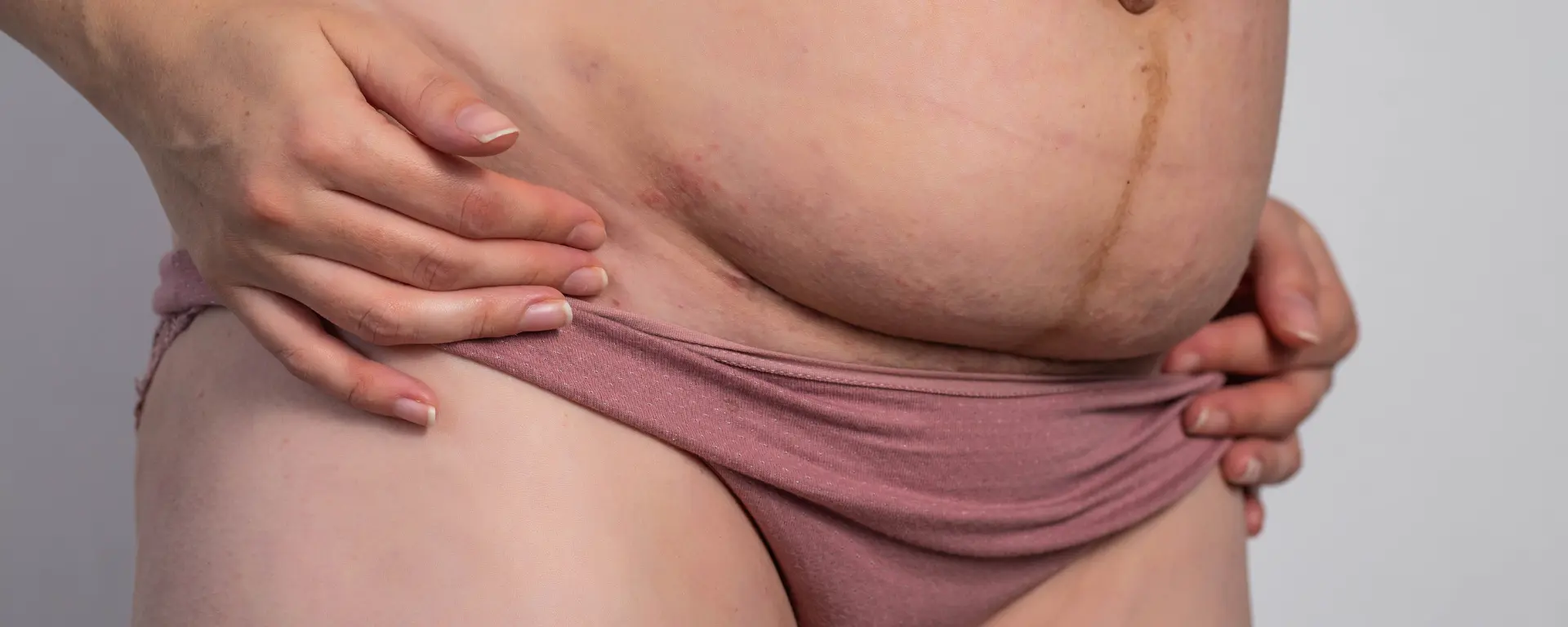How to Get Rid of C-Section – and It Isn’t Crunches
By Courtney Virden

What is a C-section shelf, and how do you get rid of it? You might be wondering what is a c shelf from c-section scars. With a C-section, your abdominal muscles and fascia have been cut through along with your uterus by an abdominal incision for your baby to be born. While some women’s scar from a C-section heals well on their own, many women are left with a C section shelf pooch and lumps under their C-section scar.
Symptoms from Restricted C-section Scar Mobility
Common symptoms women experience from a C-section scar with mobility issues are:
- Urinary urgency (feeling like you have to urinate frequently)
- Urinary frequency (feeling like you have to urinate often)
- Pain with intercourse
- Numbness
- Decreased sensation
- Tingling
- Pelvic Pain
- Pelvic floor muscles are imbalanced
- Abdominal weakness
- Lumps and adhesions
Fascial adhesions and scar tissue in our body creat dysfunction and issues and something that should always be addressed.
What Are C-section Scar Overhang and Lumps From?
You will have a scar at the incision site of your C-section, and it takes about six to eight weeks to recover from the procedure and resume normal activities. While the cut heals, many women are left with C-section scar tissues and big or pea-sized lumps on the C-section scar. Some have a hanging belly and loose skin, which is common even with a vaginal delivery. As our body heals from the incision, our fascia can densify and leave lumps through the C-section scar healing stages. And for some, the fascial adhesions and lumps can be painful, and many women do not like how it looks, making them self-conscious.
Some women search for the best C-section scar treatment and think they need a C-section scar revision or tummy tuck. Yet many women can see dramatic improvement by Fascia Blasting the scar and pelvic floor programs/therapy and our u Pelvic Floor Challenge with Ashley Black can help you ge the support and tools you need. You can do a C section scar massage with your hands, but I prefer FasciaBlaster tools for massaging your C-section scar and that is what we use for our challenge. Massage helps break down fascial adhesions and realign the collagen fibers. You might be wondering when is it too late to massage scar tissue. It is never too late! Some women develop keloid scars that are raised and thick and beyond the original boundaries of the scar. Massaging your scar as soon as your doctor says you are ready can help prevent keloids in some women.
C-sections Scars and Pelvic Health
While many women believe that with a C-section, they will not encounter bladder leakage or other pelvic floor issues, long-term data shows otherwise. The prevalence of pelvic floor dysfunction is similar in women who deliver via C-section or vaginally. A C-section and cutting into the muscles and fascia can cause misalignment in the pelvic floor muscles and reduced sensitivity.
Some common pelvic floor issues experienced by women are lower back pain, bladder leakage, frequent need to pee, painful intercourse, hip or pelvic pain, constipation, prolapse, and bowel or other bladder issues. In addition to those issues, about 40% of women still have diastasis recti six months postpartum. Diastasis recti is an abdominal separation and an overstretched linea alba (midline fascia connecting the rectus abdominis). This leads to a pressure problem within the core and should be addressed along with resolving any pelvic floor issues you experience.
Our programs are designed to help rehab your pelvic floor and fix a diastasis recti gap. Those with severe diastasis recti might need to run to surgery, but even some of those women can help it heal on their own with the right program. Using a ball with ours allows women to activate and strengthen the entire core with every exercise while improving stability more than doing exercises on a mat.
How to Massage a C-section Pooch/Scar
You can use the same movements with your hands if you do not have the FasciaBlaster tools. You will want to FasciaBlast on warm tissue, so take a hot bath, shower, or start your massage after brisk movement.
Wait at least six weeks postpartum to begin scar tissue massaging; some women must wait eight weeks or more. The healing process can take time; before you start a routine of massaging your scar, get clearance from your doctor. Some women get a vertical incision for their C-sections, and they take a little longer to heal and leave the mother unable to deliver vaginally in the future.
Begin FasciaBlasting lightly and have your skin prepped with oil and tissue warm. Use quick up-and-down and side-to-side movements. Pick a direction and do a couple of minutes one way and then switch to the opposite direction. Do not use circular motions. Pay extra attention to any lumpy areas. You can revisit those with the Nugget after your use the claw blasters. When you use the Nugget, do a poke and wiggle. Never FasciaBlast over bruised skin.
C-section Shelf and Recovery
Remember to always listen to your body and that everyone’s healing process differs. Whether you had your C-section eight weeks or twenty years ago, massage/FasciaBlasting and pelvic floor exercises are significantly beneficial. Our Pelvic Floor Challenge is the ultimate tool for those wanting to work on their fascia and pelvic floor health. The key is consistency. Taking care of our bodies and using the tools available helps you stay healthier so you can be active with your kids and throughout your life. Your health is everything, so ensure you take care of it and invest your time now, which will pay off significantly!


